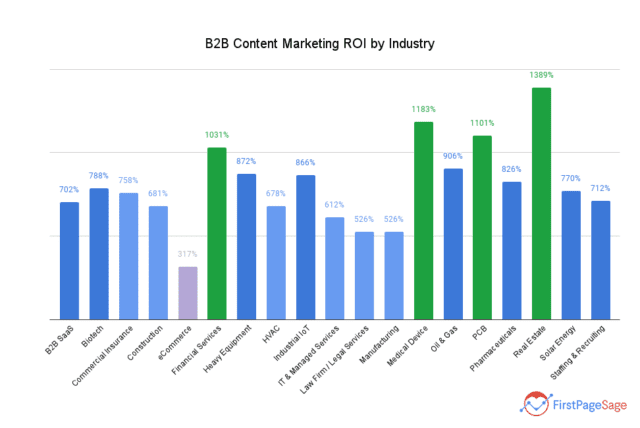
Why is an industrial blog like a sailing ship? They need a lot of parts to make it go, and they make money for the owner when used correctly. Ships carry physical cargo, and business blogs carry ideas, both valuable commodities.
Each post in an industrial blog is like a sail. One won’t do much. But many business blogs can provide a continuous source of traffic and leads, like a steady wind.
Businesses that incorporate an industrial blog on their websites generate an average of 67% more leads. Keep reading to see other benefits and how to hoist the sails on your B2B blog.
Blogs and Ships Take Time to Gain Momentum
I make the analogy that a manufacturing blog is like a sailing ship because both take time to get going. The former captain of the Star of India (image below), James Thayer, said it took a crew of 60 about an hour to unfurl and get the sails “in their gear fully.” Meanwhile, the ship slowly gathers momentum with each sail, reaching top speed as the last sail unfurls.

The first sail will move the ship forward slightly, and each additional sail adds more potential as it catches more wind. It’s the same with blogs. Each new blog adds more content and keywords for people and search bots to find your website. Unlike a ship, there is no limit. The more content you add, the higher your rankings on Google and the more traffic your blogs will generate.
The other reason a blog is like a sailing ship is that you must be patient to reach your destination or experience significant results. Commercial bloggers report that it can take 6 months to a year to see any worthy traffic and potential income from them. Once they do, it is an evergreen source of traffic, leads, and sales. A quality, relevant article can generate traffic for many years.
To learn more about creating an evergreen article, go to Brian Dean’s article, “Here’s What We Learned About Evergreen Content.”
Critical Elements of an Industrial Blog
Without diving down the rabbit hole of how to write an industrial blog, here are a few essential elements you’ll need to create a quality post every time.
- Keywords – When planning your article, keep your target audience in mind and select relevant keywords that match your offer with how your prospects search for it. Choose one primary keyword and 3 to 6 secondary keywords.
- Headline – As with every newspaper, book, or published post, the headline is critical. Studies show that 80% of people read the headline, but only 20% will read the entire article. The most effective headlines use 7 words, but anything between 6 and 12 will work.
- The Hook – The hook or introduction tells the reader why they should care about reading the article and how it will benefit them. Consider using the word “you,” use short sentences, and don’t repeat the title.
- Content – The goal of every blog is to be of help to your target audience. Give tips, insights, and experienced comments. While you’re explaining things, be sure to include various short and long-tail keywords to boost the SEO. Avoid overusing jargon, and explain it when you do.
- Conclusion – A conclusion succinctly wraps up the main points of your article. It’s vital for long articles, and it’s the place people go when they scan sub-headlines for the gist of your article.
- The CTA – While blogs are not sales pages, there is always room for a bit of self-promotion at the bottom of each blog. You can include a call-to-action (CTA) for a content offer (a lead magnet/report) in exchange for a prospect’s contact information or link to a Contact Us page.
Following these six elements will ensure you have the minimum content for a quality blog.
Course Correction – Checking results
Blogging, like sailing, takes time to get where you’re going, but it does pay off. To keep headed in the right direction, you should monitor the traffic results over time.
Software for Blogging and Traffic
One of the best free tools for measuring blog traffic is Google Analytics. You can use it to monitor five essential elements:
- Pageviews
- The average time on page
- Average pages per session
- Returning visitors
- Goal conversion rate – If you have a specific conversion goal, such as email signup.
Another tool well worth using is Ahrefs Webmaster Tools. It is free for website owners, and it helps fix SEO issues and shows backlinks. It also displays all known keywords, SEO metrics, and SERP (Search Engine Ranking Page) for every keyword. It has more functionality than Google Search Console.
Measuring ROI of B2B Content
B2b content is a moving target. So, how do you measure its ROI? We use the same formula for any return on investment:
(Return – Investment Amount ÷ Investment Amount) x 100 = ROI
The chart below shows some average content ROI by industry.

The “Return” part of the equation refers to whatever you consider to be a conversion, such as an email signup, booked call, or a sale. The “Investment” is all the expenses related to creating and posting content.
As you can see, blogging and B2B content marketing have a positive ROI despite the industry.
Setting the Course for Your Blog’s Final Destination
Successful blogs have a purpose and a goal for the reader to reach. It may be to educate the reader about a specific aspect of your business or a particular product.
Before writing a single outline or series of blogs, keep your target audience in mind and how the information will benefit them. What is the main takeaway?
Whenever it’s relevant, use a CTA to help your reader achieve their goals and move further along your sales funnel.
Outsource Your Manufacturing Blog
Blogging can be a full-time task. Researching keywords, competitors, and trends takes time. So does writing, editing, and publishing. Most companies outsource their blogging to trained writers who understand their company and target audience. If you are ready to start or re-start your company’s blogging efforts but don’t want to do it in-house, talk with us. Grover’s copywriting can handle your content, help create B2B blog ideas, and make your company a thought leader while building 100% original content that will attract qualified leads. Contact Us today to hoist new blogs on your site and start capturing leads like wind in a sail!